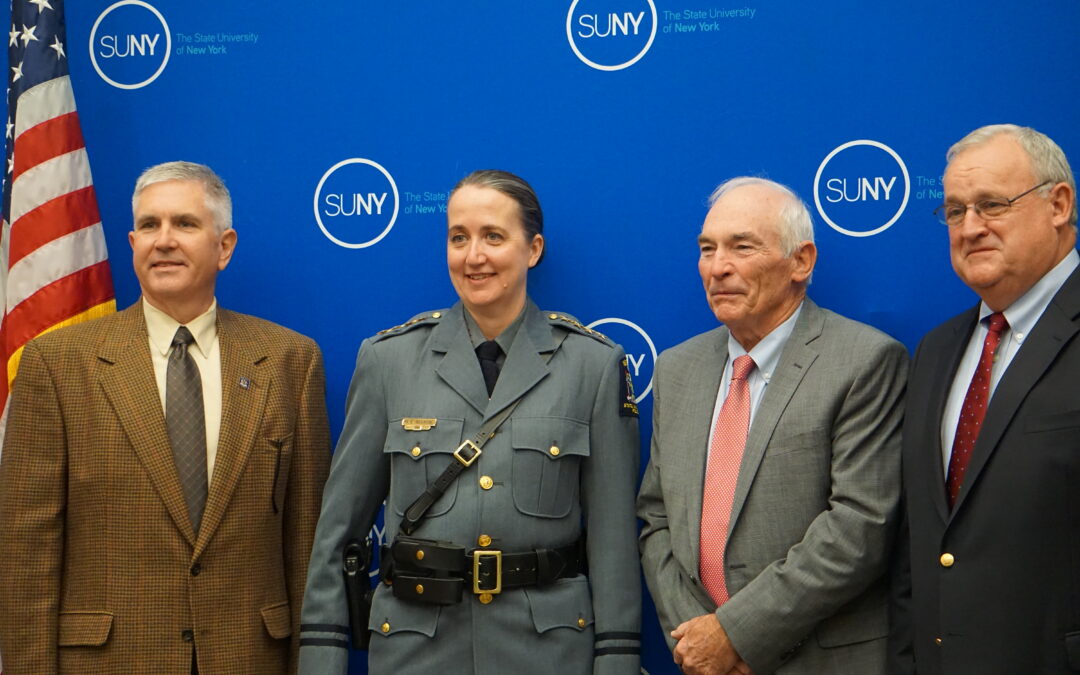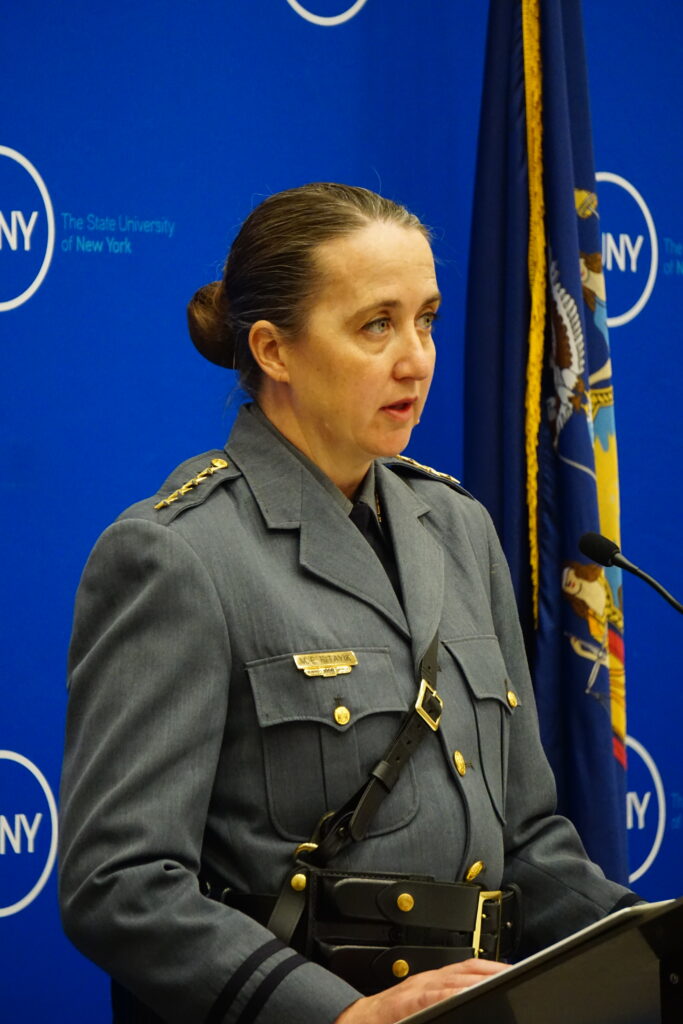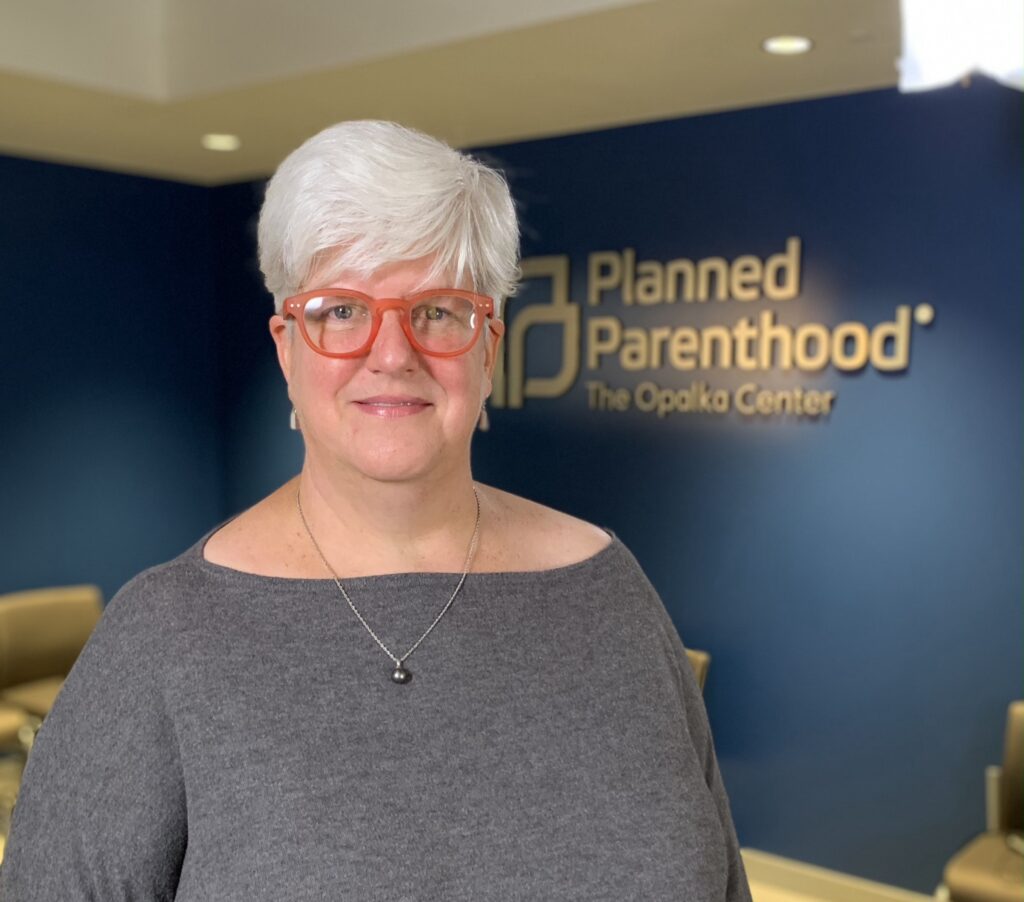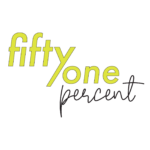
On this week’s 51%, we stop by the swearing in ceremony for Mary Ritayik, the first female police commissioner of the State University of New York. We also check in with Chelly Hegan of Upper Hudson Planned Parenthood following the Supreme Court’s hearing on Dobbs v. Jackson Women’s Health Organization.
Guests: Mary Ritayik, Commissioner of SUNY University Police Department Commissioner; Chelly Hegan, president and CEO of Upper Hudson Planned Parenthood
51% is a national production of WAMC Northeast Public Radio. It’s hosted by Jesse King. Our executive producer is Dr. Alan Chartock, and our theme is “Lolita” by the Albany-based artist Girl Blue.
Follow Along
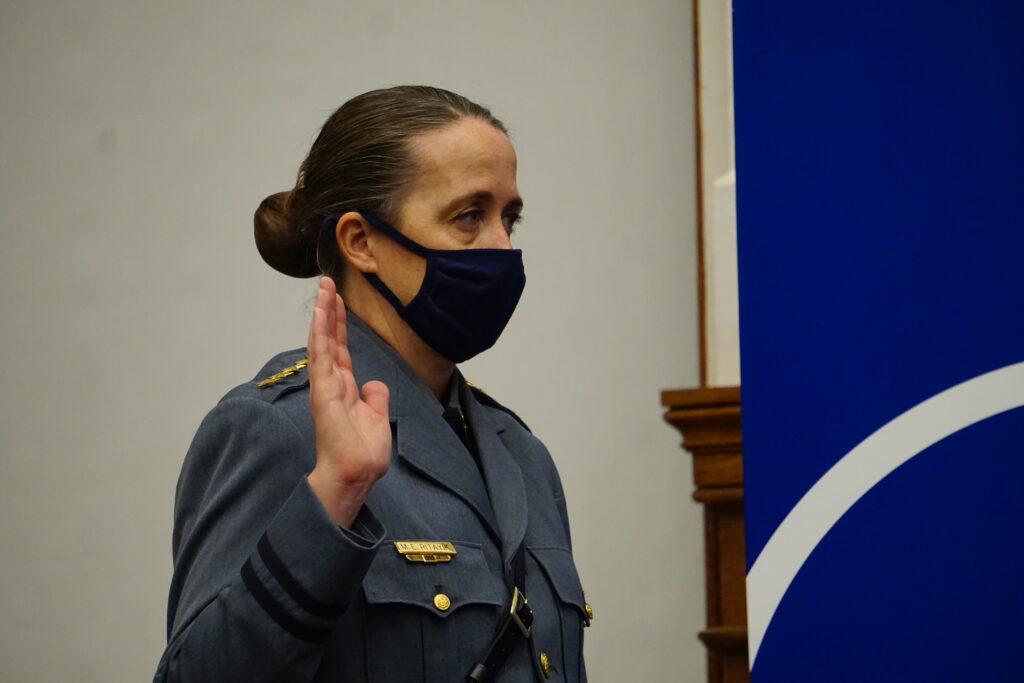
You’re listening to 51%, a WAMC production dedicated to women’s issues and experiences. Thanks for tuning in, I’m Jesse King. This week was a big week in terms of women’s issues — we’ll discuss the Supreme Court’s hearing on Dobbs v. Jackson Women’s Health Organization later on in the show. But first, we’re stopping by the Albany offices of the State University of New York, or SUNY, which recently swore in its first female police commissioner. SUNY has roughly 500 police officers across 64 colleges and universities. Mary Ritayik started out as a campus police officer at SUNY Purchase, and later became the first female police chief at SUNY New Paltz in 2019 — so the milestone is not exactly new to her.
Ritayik was particularly recognized at SUNY New Paltz for her efforts on community policing and “bridging the gap” between college students and law enforcement. It should come as no surprise that, just as police departments across the country have faced outcry and debates over police brutality, racial bias, defunding, and labor shortages, so have campus police. At the time of Ritayik’s swearing in, SUNY Plattsburgh was in the process of facilitating discussions between the student body and law enforcement amid fallout from a Black student’s arrest at what started as a routine traffic stop.
At New Paltz, Ritayik was no stranger to these discussions through the creation of her University Police Department Advisory Committee, which brought together students, faculty, alumni, and officers to discuss police interactions with Black communities and other minority groups. Following her ceremony, I got the chance to sit down with Ritayik to get an idea of what students can expect, learn about her career so far, and ask about her goals for the university system as a whole.
What does your job look like on a day to day basis? When do you get called to deal with a situation?
Usually it’s any issue on a specific campus. But it’s also the good – I know [at the ceremony] they talked about [how] usually when you get called, there’s a negative thing going on. But it’s any kind of high-priority issue, or a staffing issue or something going on within that specific UPD that could affect everybody else, too. And I’m also the point of contact for if they need something, and they’re trying to do something, you know, policy wise, in Oneonta [for example]. I need to know what that looks like, and have the best practices in place for them. But also, [if] another campus [is] doing what they’re trying to get done at Oneonta, [I] point them in that right direction to kind of, “Hey, talk to this person. This is what they rolled out for like, a UPD Committee. We all kind of talked about our different ones and what’s working, what’s not working, kind of the best practice as well.” But I’m kind of that that liaison here at SUNY that manages all the different things going on.
One of the things that they were talking about during the ceremony is how policing on campus is different than policing in a municipality. What are some of the differences? What are some of the similarities? What are the kind of issues that you guys are dealing with on a day-to-day basis?
I mean, it’s a different group of individuals on campus. So you really have your focus on that educational foundation. You have your employees, who work with students or work for the college; you have your students, who are there to get their education. And then also, it’s like a little microcosm of society where you have things that do occur on campus – where you have, you know, 10,000 individuals living on campus -= you do have some crime or areas of safety concerns where you need a police department to help assist in that. What’s unique also is the fact that it’s a group of individuals that are just learning, or just becoming responsible adults. So they’re kind of just getting out of living at home and experiencing life events. And it also lends itself to community: you have your residence hall communities, you have your student groups, your organizations, your fraternity, your Greek life. So there’s a lot of different communities. It lends itself to those great opportunities, where [in a municipality] you really have to really work hard to meet with community groups, and establish that relationship. So it lends itself to a very good opportunity for relationships to occur.
What are your priorities as commissioner?
It really is to go back to that backbone of community policing – we’ve done it forever, and we did it before they even dubbed it “community policing” – and really connect with the community. I think there is that mistrust between the police and community as an institution overall. Our role is, yes, we’re police officers. So individuals see us as an NYPD officer, or a Minneapolis police officer. And we really have to go back to what our foundation is – [that] we’re different. We’re university police officers. Yes, we will handle those situations where it’s a safety risk or concern, but what we’re doing is different here. And we’re really building that community trust and coming to the table with this as the community: “This is your police department, we need to hear the feedback. Is there an issue? Is there a problem? What can we do to make it better?”
When I first saw that you had gotten the position, the release said that you are focused on a student-focused approach. Can you go into a little bit about what that means?
It’s really what the students needs are: do they want to feel safe? Do they want to be able to go to class and feel comfortable, and feel that they can see a police car and have a good feeling about that? You know, not like, “Oh my gosh, the police. It’s a negative thing.” So really looking at how we can better that relationship with students and that younger generation as it comes, as they go through their years of college, to really build a better student approach. What the students feel is a safety need we police officers may not realize that’s a concern. So really getting that feedback from students is really important.
I know [in New York] municipalities were tasked with looking at their police departments and seeing how they could reimagine policing. Is that something that happened in SUNY?
It was the executive order that Governor [Andrew] Cuomo did, where he put it on municipalities and towns and villages to really look at their police departments and how to better improve and reform what their policies were, and how to make it better. The actual executive order didn’t apply to state agencies. So technically, no, we didn’t have to finish something by April 1 and have it delivered to the governor’s office – but you can’t just sit back and say, “Well, that doesn’t apply to us.” And you know, it’s such a bad image when you think of that. So really, it’s doing something parallel – but keeping it consistent and keep it ongoing. You know, some departments, some sheriffs or [counties/municipalities], they had to have that report, and then it was given, and then they say they’re going to do that. But like, is it reviewed all the time? I wanted something consistent. I wanted our department to consistently look at our policies, what we’re doing, and are we doing the best practices that are out there. So for that reason, we did something parallel to it, to make everyone understand that we’re not going to just shut down and say, “Well, that doesn’t apply to us.”
And this was while you’re at SUNY New Paltz.
Yes.
The University Police Department Advisory Committee, was that a part of it?
Yeah. And, you know, we were finding that individuals, whether they were students, or staff, or visitors that were on campus – they didn’t have an outlet to go to if there was an issue that they had with an interaction with an officer. They didn’t feel comfortable going to the police department, and saying, “Officer, so-and-so pulled me over, I have an issue with how he treated me.” So it really was a group of individuals who were experienced in law enforcement in some way, or they were studying it (students who were studying it), or they had a role on campus that they were a voice for students. So it was a group of individuals that we put together to say, “Hey, look at UPD, look at what we’re doing. Are we doing a good job?” It also was an avenue for me to use saying, “This is why we do these things. You know, it’s not to persecute an individual or group of people. This is the safety concern we have. And this is why we do it.” So it was a good platform to have, like a neutral platform for us to give our feedback on policies, use of force, things like that – where they can then know it’s coming from this group of people, to explain it like, “This is why the police did A, B, C, and D on that traffic stop.” [To] kind of have a more neutral voice explain what we do. And they also then do the opposite [for us] with incoming feedback from the community.
Do you see something like that happening on a broader, SUNY-wide scope?
Perhaps? I know each individual campus has some form, or they’re in the process of doing it, and some campuses have had it for years. And it’s a little different, it’s come together when there’s major issues going on, and then the group also changes as well. You know, you have different individuals that retire, or they go to a different campus for their employment. So the group of people kind of fluctuates as well, I suppose, especially with students.
Just looking at some of the other issues that people deal with on campus. I went to SUNY Oneonta, personally, and a lot of things that you would see campus police called for would be either like on-campus parties or marijuana use, stuff like that. With the state’s new stance on marijuana, how does that impact things at campuses? Or does it impact the way you guys have to deal with things at all?
It does a little bit, because campuses still have to adhere to federal law. Cannabis is still illegal federally, so for any kind of higher ed institution, it’s still not allowed, it’s prohibited. So the use, having it, the paraphernalia – it’s still not allowed on campus. It’s a different role of who handles it now on campus. There’s no criminal component anymore to it. So the roles of UPD have changed, and the roles of other professional staff or paraprofessional staff in the residence halls, their rules are now looking at it differently as well. It’s still prohibited. It’s just not criminalized anymore.
Another thing that has been a pretty big topic in colleges across the country is how schools are responding to reports of sexual assault or sexual harassment, and Title IX issues. Is there anything you’d like to see changed in New York state on that front?
I mean, I think we’re on a great path for dealing with sexual harassment and sexual assault. You know, in my career, I’ve seen a definite change of how it’s viewed from students, and how they deal with it, and from staff and Title IX. I mean, when I first started, there was really no Title IX investigator or office, so the transition going across my career is really putting that at the forefront of what can happen on campus. And you have the “Enough’s Enough” legislation…you need to address sexual assaults on any campus, whether it’s SUNY, or any private institution. So it’s headed in the right direction, but unfortunately, it still occurs on campuses.
Now, I know some police departments have had either staffing shortages or trouble recruiting during the past few years. Is that something that’s been happening in SUNY?
It’s difficult. We have to go through New York State Civil Service to hire our officers, and the way that system is set up, it’s testing, and if you want to be a police officer, you wait for the test to happen. And sometimes they only happen [every] three or four years. So you have to hit at the right time, when you’re interested. And then score well, and then wait for a campus to canvass you, interview and go through that process. So there’s a lot of steps. It would be nice to see it a little bit easier, and reach out to more communities that can take the test and be qualified candidates for it. But right now, we struggle with that, and that’s a big hurdle with trying to get hiring. And it’s also a field that is evolving into…you know, those who wanted to be police officers are now kind of going away from the field just because of where we currently are with the focus on law enforcement. So people’s career choices aren’t geared towards law enforcement.
For the past year and a half, going on two years now, what has it been like working in campus law enforcement, when classes have either been completely disrupted, or things have been very unstable?
It’s been interesting. For us, we are dedicated to the actual campus proper, so when you pick up your total on-campus population and you send them all home, we’re left with an empty campus. You still need to be here, you still have to make sure there’s nothing going on on-campus that involves criminality, but the population is gone. And it’s not only students, but all your community members and your staffers are gone as well. So for the everyday UPD officer, they still came to work, and they still had to adhere by the COVID regulations. So there was a little bit of juggling with making sure our officers were in a safe environment when they were approaching or doing their day-to-day things like you know, just walking through a residence hall was something they did. Everybody has dealt with COVID in some way or another, it was difficult, but we’re getting through it.
You mentioned something during your speech that I thought was interesting, too, about the focus on both officer health but also mental health. I mean, people are burned out in fields across the U.S. But is there burnout in policing?
Yes,it was even before COVID. It’s an ongoing thing [with the] taboo of mental health, and it applies to officers as well. You’re that strong individual that needs to approach a scene, no matter how gruesome or how horrifying or upsetting it is, and you have to be that person that’s level-headed, and gets it squared away. And you have to take in what you’re looking at, and shove it back to the back of your head and deal with it and process it later. That catches up to officers. It’s like, how do you cope? And we need to do a better job with getting our officers to decompress in a healthy manner. Not, you know, going home and having a drink or, you know, doing something else or just tuning it out. Because you really you have to deal with that to move on. And that’s why you’ll see there’s a lot of suicides in law enforcement, and it’s really [about] taking care of our own. We expect them to go through all these things, see all these horrible things at times, or deal with like a victim and hearing that story, and trying to get them help – and sometimes you can’t help them, and then having that rest on you. We’re doing a disservice to officers if we’re not getting that mental health that they need.
And it’s also, you know, a cultural change in law enforcement, where officers didn’t want to say, “I need help, I’m struggling.” It made them look weak, like they can’t handle the job. And then some officers quit, but you have really good officers that, if they can recognize that they need help, you want to keep those officers, because they’re trying to deal with what they’re going through.
You’re the first female police commissioner here at SUNY, and you were the first female chief of police at SUNY New Paltz as well. What do those milestones mean to you?
I mean, it’s different for me. I kind of downplay it, when people say, “Oh, you should be up-playing it.” But when I think back and look at it, I’m very proud that I was able to make my way through this group of individuals and kind of rise up that way, amongst mostly male peers, and that they saw something in me. I continued to push through each promotion and realized it’s my merit. It’s not my you know, [my gender]. After a while, I felt like, as an officer and an investigator, my gender, or how I was a female versus male – that got lost. You were just investigator at the time, or you were an officer. The group of individuals I was able to work with were really welcoming in that, and they did not really give me much issues with the fact that I was female. But there is a different way you actually have to…unfortunately have to prove yourself, whereas your male counterpart and officer doesn’t necessarily have to do that. Whereas a female will come in and they’re going to judge that female and see how well they perform, and then accept the fact that they’re a female officer and one of one of the group.
Thank you so much for taking the time to speak with me. Is there anything that I’m missing that you’d like me to know?
You know, I think I want to get a more standardized policies and the way we do things across SUNY – which is difficult, because there’s so many different ways people are doing things. Not that they’re the wrong ways. It’s just kind of getting us on a level playing [field], where you have an officer from one place can go to another SUNY and everything’s done the same way. So it’s really kind of getting the group of departments on the same level, standardize policies and practices, and doing those best practices in the best way we can.
Now to perhaps the biggest story this week: on December 1, a divided Supreme Court discussed the future of Roe v. Wade as it appeared ready to uphold a Mississippi law banning abortion after 15 weeks. In Dobbs v. Jackson Women’s Health Organization, the state of Mississippi is asking the Court to overturn Roe, the 1973 landmark decision legalizing abortion during the first two trimesters of pregnancy, and return the issue to the states. While New York codified abortion rights into state law in 2019, the case has had local providers concerned.
Back in August, I spoke with Chelly Hegan, the president and CEO of Upper Hudson Planned Parenthood, about a different (and more restrictive) abortion ban in Texas — but she says she’s been dreading the Dobbs case for months. I checked back in with Hegan briefly after the hearing for her reaction.
What did you make of today’s hearing?
I think it’s a really sad day for the Court and for the country. I think it was Justice Kagan who pointed out that making politics out of Roe is playing right into the hands of saying that the Court is a political body. You know, we had other cases that were essentially identical cases (to Dobbs v. Jackson Women’s Health Organization) that the Court did not hear because of the precedent of Roe v. Wade. This case was taken up with the sole purpose of a direct assault on Roe, so that feels pretty sad.
The state of Mississippi in this case is essentially asking to overturn Roe and Planned Parenthood v. Casey, and return the issue of abortion to states. What would that mean for Planned Parenthood and other abortion providers across the country?
I think it means two things, in a broad sense. For starters, we have 16 states that have trigger laws on the books right now. Boom, those states will have no access to abortion for people who live there. Which means, depending upon your ability to pay to get out of there, your freedoms are going to be limited if you live in those states. And 24 states in total are really poised to severely limit access to abortion. So we’re looking at half of our country having no access, or very little access, to basic health care. And that is discriminatory at its core. There is always a way for a wealthy white woman to get an abortion if she needs one. It is not always possible for an immigrant person, or a Black or brown person, or a person who’s living paycheck to paycheck to be able to access abortion if they want to. So that’s one thing.
But I think it’s also important to know that these are all places where abortion has been under attack for decades. And so we do have rights in some states, but it doesn’t mean that we have access in other states. Mississippi is talking about closing its only abortion clinic. It’s hard for us in New York to imagine what that’s like — there is no abortion access in several states in the country right now. Many more have one, maybe two providers. Here in the northeast, we have this experience of more dense populations, we have more access and more freedom. And we all live in the same country. And it doesn’t seem right to me that we have more freedoms than our brothers or sisters in Texas or in Nebraska.
Today, there was a lot of discussion around fetal viability, and that mark where a law might say abortion is no longer allowed. Like, “Why shouldn’t Mississippi put that line at 15 weeks?” Or, “Why is the current line at like 22 to 24 weeks set by Roe more appropriate?” What do you make of the conversation around that?
I think that’s been a problem with Roe since Roe was written. Roe says that the state has a vested interest in the pregnancy after the point of viability. Viability has always been a sort of quasi-science, quasi-religious conversation. Some religions see conception as the moment there’s a life. Other religions say it’s at birth — there is no real line. It’s an artificial conversation, and science has a different approach to it. So Roe’s always been sort of faulty on that point. And so that’s part of what has continued to cause this churning fight. It’s, “Well, what do you mean by viability?” I think one of the arguments today was that science has changed so much, so viability is earlier than it ever was. But the reality is, viability is not 15 weeks. And so even if you want to make a purely viability argument, could this pregnancy exist outside of the parent’s body as well as inside? That’s not 15 weeks.
Aside from the conversation about viability, there’s the matter of whether it’s possible to seek care and an abortion in 15 weeks.
I mean, that is always a conversation. I think, for people who have struggled with their fertility, so really worked hard to become pregnant, they probably have a hard time understanding that. Or people who who have never been [pregnant] or could never become pregnant, like Justice Kavanaugh, for example. 15 weeks seems like, “Oh, of course, you’re gonna know long before then.” But for young people who may not yet have regular periods, for people with certain BMIs whose periods may be non-regular, you’re really only talking about three periods. So the first one may have come, you know, you’re eight weeks before you know it, and you can get to 12 weeks and still maybe have spotting. So it’s entirely possible that people who are not seeking pregnancy, who are on contraception, find themselves pregnant and don’t know it. It is not typical, but it is certainly not impossible.
In New York state, abortion rights are pretty well protected by the laws here. But what are you hearing from abortion providers in other areas of the country?
People are really brokenhearted about what this means for our patients. And I think it’s so easy to have politicized this discussion. Our country’s always been very good at demonizing women and judging women for the choices that they’re making. And for providers in states across the country where they’re going to have their hands tied and be unable to provide their patients with the care that they’re coming to them for, is absolutely heartbreaking.
A decision on the case isn’t expected until the summer, but what do you see as being next? Are there any steps that abortion providers can take in the meantime?
I think that’s a fantastic question, Jesse, because I am asking myself, like, “What can I do?” Really quick, to remind anybody who will listen: if you’re in the Capital Region and you need services, our doors are open, and they’re not closing. And yet, my heart is just broken for people across the country who are looking at this dramatic limitation on people’s basic right to freedom. I think all we can do is raise our voices. All we can do is keep the gas pedal down and say, “This is not OK.” Be loud, be aggressive about it. At any turn, vote in your primaries, hold politicians accountable for what’s happened. Be prepared and start preparing. How are we going to get medication, abortion drugs to people who need them? There are not-for-profit organizations that have been working with countries that have severe access issues for people in those countries. We can do that here in this country. We’re going to have to treat part of our nation as a third-world health care access space.
I just want to call out one of the things Justice [Sonia] Sotomayor said. She said, “Will this institution survive the stench that it creates in public perception that the Constitution, and its reading, are just political acts? I don’t see how we survive that.” You know, and then you think about our institutions across the board — we’ve got people who are still debating whether or not the election was won. We have people who are debating basic facts. And now we have the Court being thrown into this very political space. So do we, collectively as Americans, believe that the Supreme Court speaks for us, and that we need to be held to the standard that they hold up for us, if it is so clearly politicized? I think those are incredibly dangerous things for our democracy.
You’ve been listening to 51%. 51% is a national production of WAMC Northeast Public Radio. It’s produced by me, Jesse King. Our executive producer is Dr. Alan Chartock, and our theme is “Lolita” by the Albany-based artist Girl Blue. Thanks to Commissioner Mary Ritayik, Chelly Hegan, and you for participating in this week’s episode. Until next week, I’m Jesse King for 51%.
